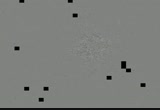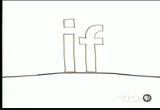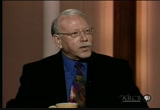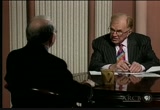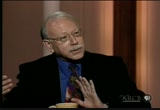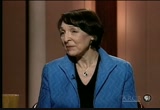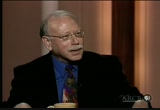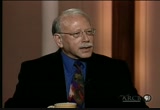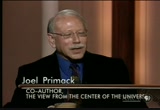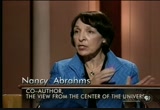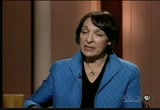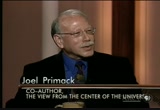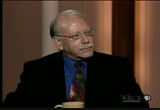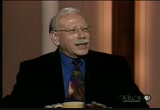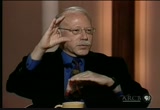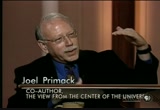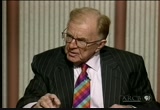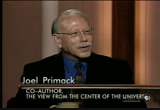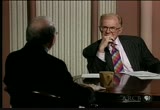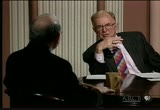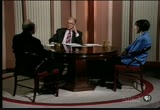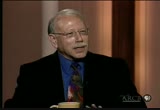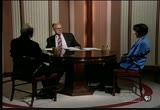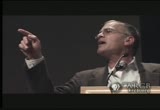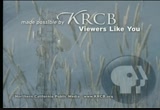tv John Mc Laughlins One on One PBS October 2, 2011 9:00am-9:30am PDT
9:00 am
that's, seti, the search for extraterrestrial intelligence, has scoured the galaxy listening for signals of alien civilizations. so far none have been detected but scientists believehey already know plty about alien life and the reasons why it would resemble life on earth. what does the evolution of life on our planet tell us about the likelihood that alien civilizations exist? in the second of a two-part series, we will ask one of the originators of the dark matter theory, dr. joel primack and nancy ellen abrahams.
9:01 am
if. for such a small if i live to a hundred. if social security isn't enough. if my heart gets broken. if she says yes. we believe if should never hold you back. if should be managed with a plan that builds on what you already have. together we can create a personal safy net, a launching pad, for all those brilliant ifs in the middle of life. you can call on our expertise and get guarantees for the if in life. after all, we're metlife. this is the second session with two extraordinary people, nancy abrahams wosay lawyer, a song writer, a spouse, and the coauthor of this volume,
9:02 am
which is quite breathtaking. the view from the center of the universe. discovering our extraordinariy place in the cosmows. a new book. -- cosmos. highly placed and the coauthor is sitting right here, his name is joel preand he is one of the world's most successful and recognized cosmonthlygists, astro first cysts. and this is a tour of the universe benefiting by the extraordinary breakthroughs of a series of telescopes, the head of which is the leading telescope is the hubble telescope which is still functioning. now, the hubble is a product of nasa. so you must have high regard for nasa? is that deminished in any way? >> all of us scientists are enormously grateful for the government of the united states and to nasa in
9:03 am
particular. but we are very worried that this new focus on putting people back on the moon is robbing the current scientific enterprise of very much-needed resources. in the hopes we'll be able to do something in 10-20 years we have already done. namely put people on the moon. we really have major projects that we would like to do now that are being postponed in many cases indefiniteliy because of this new focus on the moon. >> what do you have in mind? >> one of the major projects is to lis for gravity waves either from colliding enormous black holes at the centers of galaxies or even from the big bang itself. that's a space project that we love to see go forward rapidly. there are a number of other projects that along with that one our group is beyond einstein. they are trying to take us beyond what we already know
9:04 am
and see if there are any flaws in relativitiy and also to see if relativity really works and the most extreme environment, the whole universe right up close to black holes, that sort of thing. >> you're talking about the search for extraterrestrial intelligence, correct? >> that's another thing we loved to see go forward. >> that's the seti program been around for 50 years. that has enlisted 4 million, i believe, americans who have computers, for the use of those computers to continue to listen to the universe to see if there are any communication signals from an intelligence. is that correct? >> well, whatcom purts are ing is analyzing data obtained from radio telescopes. you can sign up. it's called seti at home and you can allow unused time on your pc to be used for analyzing the data. seti is about to start a major new observatory.
9:05 am
the ellena ray. >> named after paulal snen. >> who provided some of the money to make it possible. -- it's going to allow us to look 10 times further out than we have been able to listen so far for signals from possible extraterrestrial intelligence. now 10 times further out may not sound like so much. so far we have been able to go out about 100 light years this. will let us go out 1,000 light years. the volume we can search goes up boo boo by a factor of 1,000. 10 times 10 times 10 because it's 3 dimensional. so we are going to greatly increase the chance of detecting a signal. keep in mind though, if we get a signal from a civilization 1,000 light years away, it was sent 1,000 years ago. if we decide to reply, they'll receive the reply 1,000 years from now and then if they reply to us,
9:06 am
our distance is 2000 years from now. >> the likelihood of there being anything out there, first of all ncontour, in size, in complexity, that entity, that alien, would have to really kind of duplicate what we have here on ear in human beings. correct? >> it might be about the same size we are, but i don't think it would duplicate us in it's thinking or looking at reality. that would be the fascinating thing about finding it. >> i'm talking about the structure of the brain, perhaps? >> i don't think we know what an alien brain would look like. >> don't you make the case that the alien would have to proximate a human bei from earth? an earth like country snur
9:07 am
indeed. likely to be about the same size and the reason it has to do with fundamental laws of physics. it's not possible to have an intelligence that much smaller than the human brain. because there isn't enough complexity and not possible to have one that is enormously larger than the human brain because the slow speed of communication. what we have if you have a much larger entity, is a community of a bunch of separate thinking organisms because the thinking has to be done in a fairly small volume to have the repit id of the communication. so in that respect it's probably going to be like us. doesn't have to be shaped like us. >> even before you reach that stage, though, there is a setup of 6 conditions that you have enumerated in your fascinating volume. one of which is the significance of circular orbits and how common they are in the solar system. you need those circular orbits for what?
9:08 am
>> well, it's important there be large planets, jupiter like planet in a circular orbit -- >> not ellipt call. >> pretty close to circumstance lal. and the reason is that if you don't have a circumstance lal orbit, then -- sircular -- then the smaller planet's orbits will be disresult erupted. they won't be stable themselves. also jupiter has another great role on the solar system of deflecting a lost of the things that might hit earth and cause catastrophe. >> before we leave this, if the earth were to get askew, and cockeyed, your book says in a footnote, it could be remedied. it could be remedied by altering the orbit of the earth and correcting it. >> yes. >> aligning it.
9:09 am
>> yes, by using mars commet. not something we can do with today's technology but we can -- >> let's hear it. maybe this is where you want your next grant from nasa. [laughter] this could be done, that is aligning the orbits so that it spins differently and therefore i guess has a -- talking about a linear direction to it? >> actually, the proposal is -- >> let me read it. this could be done by altering the orbit of a large commet so that on its rare passages through the inner solar system, it passes repeatedly close to both the earth and jupiter and to do this, would require perturbing the commet's orbit using large rockets. it would of course be crucial to prevent this commet from crashing into the earth during these maneuvers.k
9:10 am
meanwhile, astronomical catastrophes like the one that decide the dinosaurs 65 million years ago can be a burden in the futureure by changing the orbits of astroids and comets. these tasks would require improvements in our astronomical and rocketry capabilities that should be possible relatively soon. that's a product not only of you but of fred adam, corrie can ski, & anne lock lin and their monographs. >> yes. >> so this is not too far away? >> i think it's) definatelel something that can be done in the is the sun going to age well? >> well, stars like the sun, accumulate ash in the form of mor helium at the center and they have to become hotter steadily. if the process takes a very long time. the sun will provide a
9:11 am
perfectly liberal amount of heat and light for at least another half billion years. but -- >> how much is that in the geological time sense? half billion years? that's not much. >> that't' right. but it's a lot longer than people have been around. >> this is true. now, is there a danger that the earth might get too close to the sun? >> no. the earth is going to stay about the same distance from the sun unless retake some effort to change it. >> we need a habitable zone. >> we are in the habitable zone. >> we are in the it but when we talked about the changing of the pivot, if that's the right word, the spin of t t earth so it is not -- it remains sircular. there is another reason why
9:12 am
we should keep in mind what we can do if the earth gets too close to the sun. >> the earth won't get too close to the sun but the sun will get too hot for the earth. that's the fate of the sun. it will get hotter and hotter as joel said. so the real purpose that we bring up this issue of the possibility of changing the orbit of the earth by using comets is so over the long-term we can slowly move the earth away from the sun so that as the sun gets hotter and hotter, it doesn't cook the earth. >> as have been told by the way joel is your husband in this esteamed spouseal relationship, and i was just thinking of a metaphor these two stars are in conjunction and they have been in producing this book. and you are a lawyer and congratulations on your pros of the pros are great reading. >> thank you very much. >> very lucid. this is an ar cane subject
9:13 am
and it'seso taker to almost everybody. >> if we can't reach people. if people can't understand they won't get the fact that this is their universe. this universe belongs to everyone and there is really no reason why you have to be an expert. you don't have to understand scientific theories at the level of scientists to understand the overall picture of our universe. every culture has had a picture of the universe that people shared except ours. we are really an nomly of human history for the last 400 years. we don't have a shared picture of reality. we couldn't really because 400 years ago we began to get scientific standards and there was no scientific picture because there wasn't any data about the distant universe. for now the first time in history we have a picture based on science and that describes the universe as a whole. and it is accessible. we can -- i like to use the image that just like you don't have to be an auto mechanic to drive your car,
9:14 am
you don't have to be a cosmolgist to understand the universe. you can use this picture of the universe. you can approach it through stories, pictures, symbols, which is what we try to do in the book, but it's important. because this is the unified picture of reality. this is the picture that belongs to every human on this planet. >> what about the moon? >> what about the moon? >> how is the moon age something. >> the moon actually looks very much the way it did shortly after the creation of the earth's solar system which appears to have happened because of a giant collision between the earth that and an object perhaps the size of mars. >> does it help stabilize the rotation of earth? >> absolutely t played a tremendous role in making the earth a suitable habitat for life. most of what we call the angular momentum of the earth moon system is in the moon. the thact we have such a large moon for a planet our size, it's the largest ratio in the solar system, -- . >> do you think the
9:15 am
moon -- go ahead. >> this is what kept the earth going a aund with the same kind of rotation that it has and that is what stabilizes our seasons. >> do you think the moon does more than any other force to keep us habitable in a sense because of the rotation? 23.5 rotations? at that tilt? >> the tilt of the earth's axis. that is preserved partly because of the moon. for example, mars doesn't have a large moon. it's too small moons. and the axis of mars rotation actuallyosalates silently and if mars had a large moon like earth that wouldn't happen. so this is played a tremendous role. also the tides have been very useful for a lot of
9:16 am
living organisms. >> so we have the galaxy and the galaxy is composed of what? what is the cosmic pyramid? if you have a pyramid like a food pyramid that is put out by the department of agriculture, how much of what do you have where in the pyramid? start at the top. >> well, we are made of the rarest stuff in the entire universe. >> first of all you get all those conditions together in order to have a habitable place, correct? all of these major elements and there are 6 of those that you describe. then you have to have the properties of life there. we talked about that. in the previous show. >> right. >> but what is the pyramid? >> we callj this the cosmic entity pyramids and it describes what the universe is made of. so at the top of the pyramid, you can think ever this as
9:17 am
being a pyramid on the back of a dollar bill. there is a glowing little triangle at the top. >> the med toic eye. >> right. and then the 13 steps the pyramid representing the original 13 colonies on the bottom. >> what's at the very peek? >> at the peek, is the eye and this glow around it. supposed to represent the eye of providence. what we are doing is we are borrowing that symbol and saying if you imagine the top part in relation to the bottom part as representing the volume of the two parts, representing the relative amount of the different stuff, the upper part represents the heavy elements in the universe, the carbon, oxygen, nitrogen, iron, everything except high jen and helium. all of those heaviel elements, every atom in your body that is made of carbon and so forth, was manufactured deep inside a
9:18 am
star. and that was blown out, typically in the end stages of the star's life. and later on, it became incorporatedded into our solar system, the earth and -- >> and our bodies. >> it's the rarest stuff in the universe. about 100 of a percent of the universe is made of heavy elements. that's that pyramid at the top. now the big part of the pyramid, which is about a 1/2% that is actually the visible stuff in the universe, the stars. >> that's about 25%? >> no the visible stuff, half a percent. everything we can see. -- when you look out at night -- >> i thought your dark matter was 25% and then your dark energy was what 50%? >> about 70%. >> 70? >> yes. so the dark matter about 25% and the dark at oms, the at
9:19 am
oms we can't see about 4 1/2%, that is most of the universe as far ats math and then the dark energy, the stuff making i if you add those elements up, elements, if you add those parts of the pyramid up, you have 70% that's invisible,. >> dark energy. >> then you have dark matter which is about 25%. then you are up to 95% and then you have about 4% -- >> 4 1/2% of invisible atoms. >> invisible atoms? so the universe is invisible to the human eye? >> except for half a percent. half of 1% of all we see. >> that doesn't mean it's not demonstrably there because it's gravitational?
9:20 am
but there is nothing you can see under a microscope? at this point. >> right. >> you think there will be? >> i am very hopeful in the next few years we'll figure out what the dark matter is. >> you need something from nasa to pursue that? >> we would like to have it from nasa and various other federal agencies in the united states and also other science organizations around the world. for example, next year, the europeans are going to launch a large collidener genev a there is also a lot of u.s. scientists involved. >> is that trest recall? >> it's located deep underground on the border between switzerland and france t goes all the time between -- it's the world largest at somsmasher and we are hoping with much higher energy we'll have there thanny ever had before we may be able to start making particles of dark matter. >> is that a mile in sflength? much bigger.
9:21 am
27 kilometers around. >> 27 kilometers is about 5 miles? >> no, about 15 miles. >> 15 miles. >> around. it's quite large. >> going to travel at high speeds? >> nearly the speed of light. we'll have two beams going in opposite directions pro tons hitting pro tons and they will collide with 10 times more energy than we ever had. >> are american scientists involved? >> there is about 1,000 american scientists who are heavily involved. but there are many more europeans involved. it's a mainly european project. the united states was building a similar machine in texas but stopped that in the early nintss. >> the what are you trying to find out? >> many things we want to find out. what i'm especially interested in is what the dark matter made of? what's the main stuff in the universe? we think there is a good thans this machine will allow us to produce the stuff in the laboratory. there are also many experiments going on trying
9:22 am
to detect the dark matter deep underground for example where it's shielded from cosmic rays. you think it's possible that if the dark matter is invisible, that there is anything corresponding to a human being, which might be out there, and also invisible? >> no the thing about -- >> as we understand rationalitiet and brain and the sell lawyer constructs and molecular constructs the body, there ising in -- cellular -- >> we are made of star dust. you have to understand that dark matter is simple. even dark energy may be simple. they represent 95% of the universe but they don't have nearly the complexity that atoms can have. and were made of the most complicated atoms. which are as joel said, star dust in a sense that they were cooked in the middle of stars and then burst out when the stars died.
9:23 am
so all of the really interesting complexity in the universe is happening in this very, very small amount of atoms. that's one of the reasons why we are extremely special that we are made of the rarest material in the universe. >> is there any dispute about any of this? -- is jarred diamond onboard? is guld onboard on the matter of intelligence, human intelligence is not replicable, he says, as far as he can see and he continues to say that, right? >> of course steve gouled is no longer with us. he -- >> he passed on? >> yes. he said if you replay the tape of evolution, we wouldn't be created the next time around. that we were just an accident. that's what steve gouled says. >> lauren ice league is he
9:24 am
still with us? >> no. >> he's passed on too? >> yes. >> every creature alive is the prodetect of a unique history, the nowhere in all space or in 1,000 worlds will there be men to share our lonliness. >> that's very uplifting hu? i think it helps us appreciate that we are unique. it's very unlikely as we said so beautifully, that there is going to be is there any center to the universe that is identifiable? >> no. >> there is no center? but your book says from the center of the universe, what does that mean? >> we are central in ways that derive from the principals of physics. it's not a geographical center. in the middle ages people thought the earth was the center of the universe and then people thought there was no place in the universe that was different. it was just an infinite open space.
9:25 am
we know that's not the picture of the universe now. and we have found ways that we humans are central, at the center of all possible size no, sir universe. we are made of the rarest material in the universe. star dust. we are at the center of time in several different ways. we are actually integrated into this universe in very special ways. we are not just thrown together. >> we are almost out of time. i have questions for you. do you think we are also recapittative in our entity, in our being? >> do you mean are we -- >> we capit lating the whole history of the universe? >> we actually still include much of the history of the universe because we are made of atoms were made in snars. >> do you agree with that? >> and we are made of particles that came out of the big bang they are in us. that's what we are. her creature just like us. >> congratulations on the book.
9:26 am
we are out of time. but i really enjoyed the show and i'm sure our lisners have and it's a very expansive book meaning that it is -- it gives the reader a sense of unique buoyancy and also the -- there is so much intrigue there too. thank you very much for being here joel and nancy. >> thank you. if. for such a small if i live to a hundred. if social security isn't enough. if my heart gets broken. if she says yes. we believe if should never hold you back. if should be managed with a plan that builds on what you already have. together we can create a personal safety net, a launching pad, for all those brilliant ifs in the middle of life.
9:27 am
9:29 am
252 Views
IN COLLECTIONS
KRCB (PBS) Television Archive
Television Archive  Television Archive News Search Service
Television Archive News Search Service 
Uploaded by TV Archive on

 Live Music Archive
Live Music Archive Librivox Free Audio
Librivox Free Audio Metropolitan Museum
Metropolitan Museum Cleveland Museum of Art
Cleveland Museum of Art Internet Arcade
Internet Arcade Console Living Room
Console Living Room Books to Borrow
Books to Borrow Open Library
Open Library TV News
TV News Understanding 9/11
Understanding 9/11